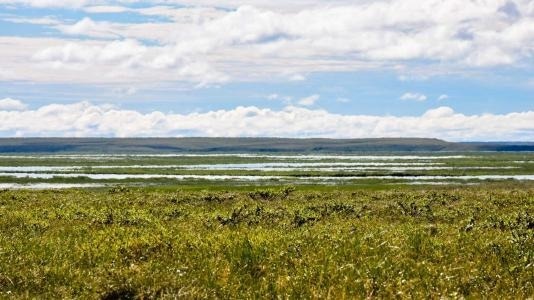Climate change has caused the Arctic to warm nearly four times faster than the rest of the planet since 1979. Increased temperatures have altered the plant communities in the Arctic and decreased the amount of snow cover, permafrost, and sea ice. Changes in this area’s energy transport between the atmosphere and the land could impact global weather and temperature patterns.

Graminoid-dominated tundra with dwarf shrubs growing in national park Kytalyk, in the Siberian Arctic. The blurred areas in the image are created by heat haze, which occurs when various surfaces heat up differently and hence create turbulence in the air. Image Credit: Gabriela Schaepman-Strub/University of Zurich
Researchers from 63 institutions, including the Argonne National Laboratory and the DOE Office of Science Atmospheric Radiation Measurement (ARM) user facility, recently assessed the effects of different drivers on energy exchange or the process by which energy moves from the ground to the atmosphere in the Arctic.
They discovered that the primary predictor of how energy is exchanged during the Arctic summer is vegetation type, which is frequently oversimplified in climate models.
I expected there to be differences in vegetation type, but not to this extent. Vegetation type had stronger predictive skill on the surface energy budget than permafrost, temperature, snow cover, and cloud cover.
Ryan Sullivan, Assistant Atmospheric Scientist, Argonne National Laboratory
The amount of energy from the sun that reaches the surface of the Earth and the amount that is absorbed or reflected into the atmosphere are described by the surface energy budget. Net radiation, sensible heat flux, latent heat flux, and ground heat flux are the four main parts of the budget.
The amount of energy entering the system of the Earth is captured by net radiation. Sensible heat flux is the term used to describe the energy transferred as heat and results in a temperature change. The energy that is kept in the ground is defined by ground heat flux.
The four main parts of the Arctic’s surface energy budget were examined in this study from June to August, and the effects of 15 drivers were assessed. Data gathered from 64 stations between 1994 and 2021 were analyzed.
The researchers anticipated that snow amount, snow duration, and permafrost extent would be excellent indicators of the four components of the surface energy budget because snow and ice reflect heat from the sun back into the atmosphere.
However, they discovered that, compared to the other tested drivers, the type of vegetation community was a better predictor of sensible heat flux and latent heat flux.
Remarkably, in summer the difference in heat flux between two types of vegetation—such as a landscape dominated by lichens and mosses and one with shrubs—is about the same as between the surface of glaciers and green grasslands.
Jacqueline Oehri, Study First Author and Postdoctoral Researcher, McGill University
The researchers hypothesized that vegetation type significantly affects the energy budget for two main reasons. First, the Arctic has a wide variety of plant communities, from grasslands to lichen-covered deserts to boreal peat bogs.
Various environmental factors, such as temperature, topography, soil moisture, and permafrost conditions, can be seen in each vegetation community. Second, the height, productivity, and albedo characteristics of plants vary, and these factors can affect how energy moves between the land and the atmosphere.
The study also demonstrated the significance of seasonality in energy fluxes by demonstrating how the impacts of vegetation type on the energy budget differ based on when snow cover disappeared in the spring and returned in the fall.
Sullivan added, “We hope that people improve treatment of vegetation type in Earth system models and use this to also better understand how these effects might change in the future.”
For instance, rising global temperatures could alter the distribution of particular plant species in the Arctic, which could have an effective impact on how energy is exchanged.
“Another novel outcome of this study was the synthesis of all the international measurements. It was a great opportunity to bring different groups together and work across disciplines,” Sullivan further added.
The study was published last October in Nature Communications.
The DOE Office of Science helped fund some of the research.
Journal Reference:
Oehri, J., et al. (2022) Vegetation type is an important predictor of the arctic summer land surface energy budget. Nature Communications. doi:10.1038/s41467-022-34049-3.